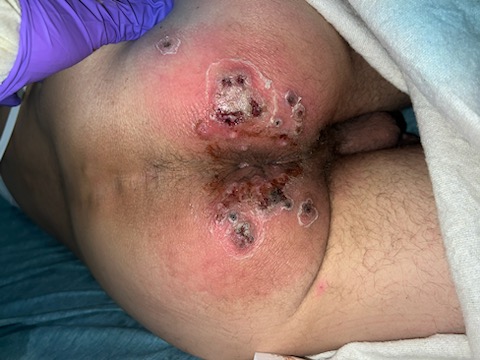Case Presentation: A 41-year-old male with well-controlled stage I HIV on Biktarvy, seizure disorder, and untreated hepatitis C presented with worsening painful itchy rash for one week. The rash began perianal and spread to his trunk, extremities, face, and scalp. He reported purulent rectal drainage with painful lumps in his inguinal and cervical areas. He denied any cough, nausea, hematemesis, chest pain, or shortness of breath. He is sexually active with multiple male partners and intermittently uses condoms; his last sexual encounter was approximately 1 week prior to presentation with multiple sexual partners. He denied any change in hygiene products, dietary changes, or intravenous drug use. On presentation, vital signs were normal. His physical exam was remarkable for several papulopustular plaques, many ulcerated and open with overall background of erythema around the peri-anal area consistent with cellulitis. The trunk, extremities, and face had areas of morbilliform, macular rash. He also had large bilateral inguinal lymphadenopathy, as well as bilateral cervical and occipital lymphadenopathy. On admission: CBC without leukocytosis, however notable for anemia (hemoglobin 12.9). Chemistries notable for hyponatremia 132 and hypokalemia 3.4. LFTs remarkable for hypoalbuminemia 3.1. CD4 count 1294 on admission, HIV RNA not detected. The following infectious workup was negative as follows: syphilis, EBV, HSV, CMV, influenza, HIV, gonorrhea, chlamydia. Patient was positive for Monkey Pox West African (Clade II) from 2 of 2 swab specimens of his superficial buttock lesions. Blood cultures grew MSSA and Streptococcus pyogenes, each from 1 of 2 sets. CT abdomen and pelvis notable for marked splenomegaly, bilateral inguinal and pelvic lymphadenopathy. Patient completed a 14-day course of tecovirimat 600mg twice daily and was started on cefazolin for 4 weeks for bacteremia. Repeat blood cultures and TTE were negative. Patient was discharged in stable condition with outpatient infectious disease follow-up.
Discussion: A recent large case series of 528 infections since the start of the 2022 outbreak noted the soft tissues superinfection in only 18 such cases, 3.4% overall, without mention of any further complication such as bacteremia.[1] It is logical that bacteremia may arise from such as superinfection, but this does not appear to have been reported to date.Monkeypox belongs to the same genus as variola and presents similarly to smallpox. [2] There have been two well-known strains of the virus, Clade 1 which is the Congo Basin strain and Clade 2 which is the west African strain.[3] The first discovery of the virus was in the 1950s, in Denmark. The smallpox vaccine, provide protection against the original strains of the Monkeypox virus.[4] Transmission is thought to predominately be from skin-to-skin contact in setting of high-risk sexual activity or close home contacts. The incubation period can take anywhere from 4 to 21 days. The virus remains infectious until the last lesion crusts and falls off. [5]
Conclusions: Although monkeypox is typically self-limited, high-risk individuals should be treated with Tecovirimat for a 14 day course duration. Monkeypox is from the same genus as variola, therefore early stages of the virus can present similarly to smallpox, herpes, molluscum contagiosum, and other pox virusesMonkeypox is transmitted via close contact and through respiratory droplets, therefore isolation precautions should be taken accordingly, and patients should be educated on transmission of the disease


